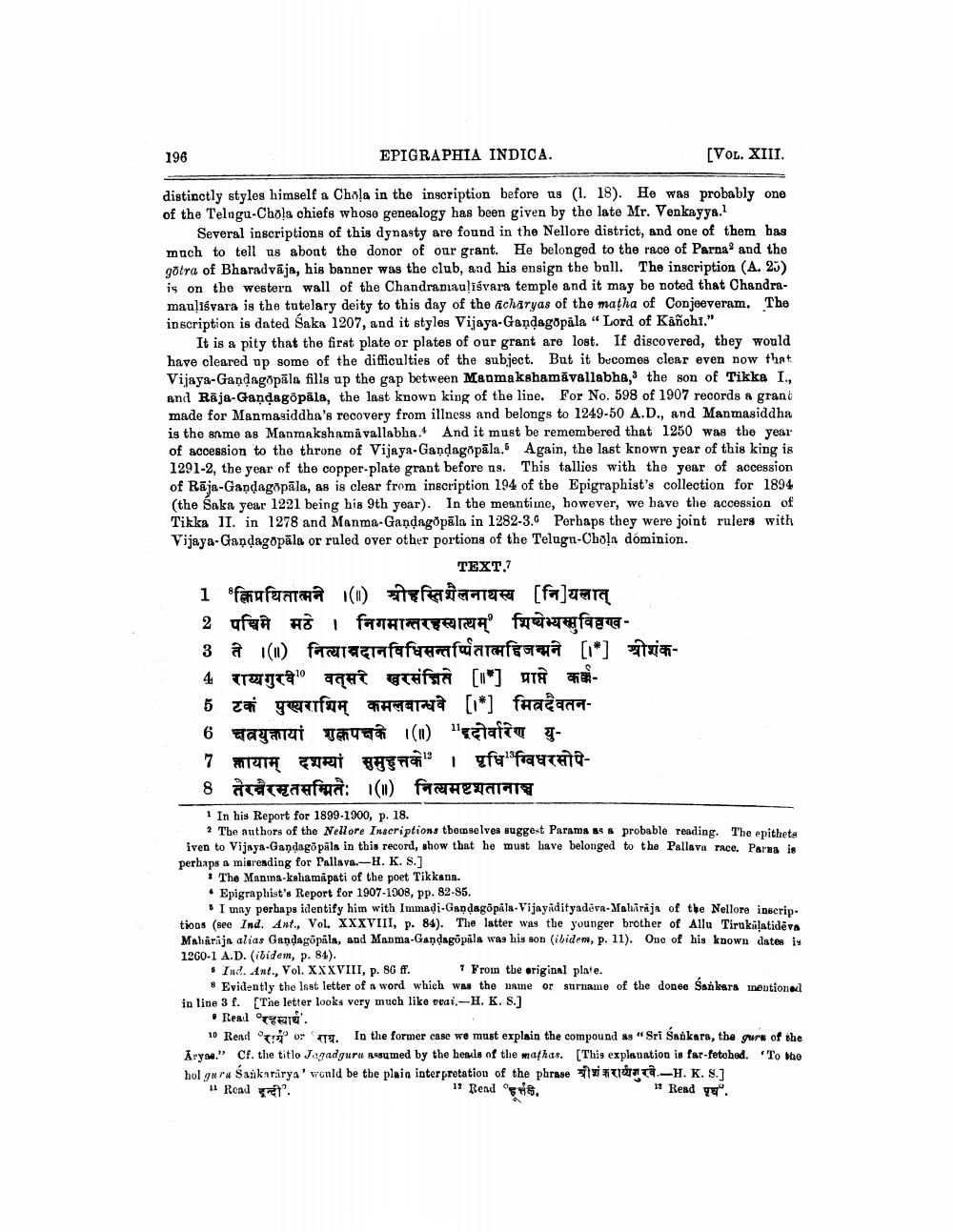________________
196
EPIGRAPHIA INDICA.
[VOL. XIII.
distinctly stylos himself a Chola in the inscription before us (1. 18). He was probably one of the Telugu-Chola chiefs whoso genealogy has been given by the late Mr. Venkayya.
Several inscriptions of this dynasty are found in the Nellore district, and one of them has much to tell us about the donor of our grant. He belonged to the race of Parna and the gotra of Bharadvāja, his banner was the club, and his ensign the bull. The inscription (A. 23) is on the western wall of the Chandramaulīśvara temple and it may be noted that Chandramaaliśvara is the tutelary deity to this day of the acharyas of the matha of Conjoeveram. The inscription is dated Saka 1207, and it styles Vijaya-Gandagöpäla "Lord of Kanchi."
It is a pity that the first plate or plates of our grant are lost. If discovered, they would have cleared up some of the difficulties of the subject. But it becomes clear even now that Vijaya-Gandagöpāla fills up the gap between Manmakshamavallabha, the son of Tikka I., and Rāja-Gandagopala, the last known king of the line. For No. 598 of 1907 records a grand made for Manmasiddha's recovery from illness and belongs to 1249-50 A.D., and Manmasiddha is the snme as Manmakshamåvallabha. And it must be remembered that 1250 was the year of accession to the throne of Vijaya-Gandagopāla. Again, the last known year of this king is 1291-2, the year of the copper-plate grant before us. This tallios with the year of accession of Raja-Gandagopala, as is clear from inscription 194 of the Epigraphist's collection for 1894 (the Saka year 1221 being his 9th year). In the meantime, however, we have the accession of Tikka II. in 1278 and Manma-Gandagópāla in 1282-3. Perhaps they were joint rulers with Vijaya-Gandagopāla or ruled over other portions of the Telugu Chola dominion.
TEXT. i araferarna () eficace [fa]gara 2 पश्चिमे मठे । निगमान्तरहस्यात्थम् शिष्येभ्यस्मुविवव - 3 â (1) fragrafafanuacia [1*] - 4 tergra aqa grefsta [ ] ATA 5 tai gethu F t [*] fraèana6 ayamat Tara (1) gelating 7 miera URT HET" I fafauceta8 acatwaafua: (n) FARHAATAT
In his Report for 1899-1900, p. 18.
? The authors of the Nellore Inscriptions themselves suggest Parama as probable reading. The epithets iven to Vijaya-Gandago pals in this record, show that he must have belonged to the Pallava race. Parna is perhaps a misreading for Pallava.-H. K. S.]
The Manina-kohamapati of the poet Tikkana. • Epigraphist's Report for 1907-1908, pp. 82-85.
"I may porhaps identify him with Immadi-Gandagopala-Vijayadityadeva-Maharaja of the Nellore inscrip. tions (see Ind. Ant., Vol. XXXVIII, p. 84). The latter was the younger brother of Allu Tirukilatidėva Mabaraj alias Gandagöpala, and Manma-Gandagõpāla was his son (ibidem, p. 11). One of his known dates in 1260-1 A.D. (ibidem, p. 84).
. Ind. Ant., Vol. XXXVIII, p. 86 ff. Froin the original plate.
8 Evidently the last letter of a word which was the name or surname of the donoe Sankara mentional in line 3 f. [The letter looks very much like uvai.-H. K. S.]
• Real ory
10 Rend T OM TO. In the former case we must explain the compound as "Sri Sankara, the gure of the Aryse. Cf. the titlo Jugadguru assumed by the heals of the mathas. [This explanation is far-fetched. To the hol guru Sankarirya' would be the plain interpretation of the phrase 11 g .-H. K. S.] Read इन्दी'.
11 Read qu.
12 Rend
nie.




